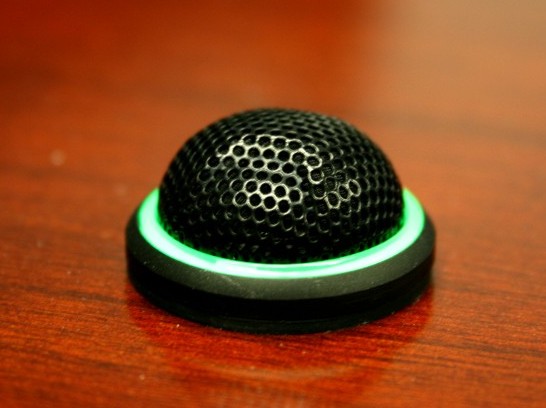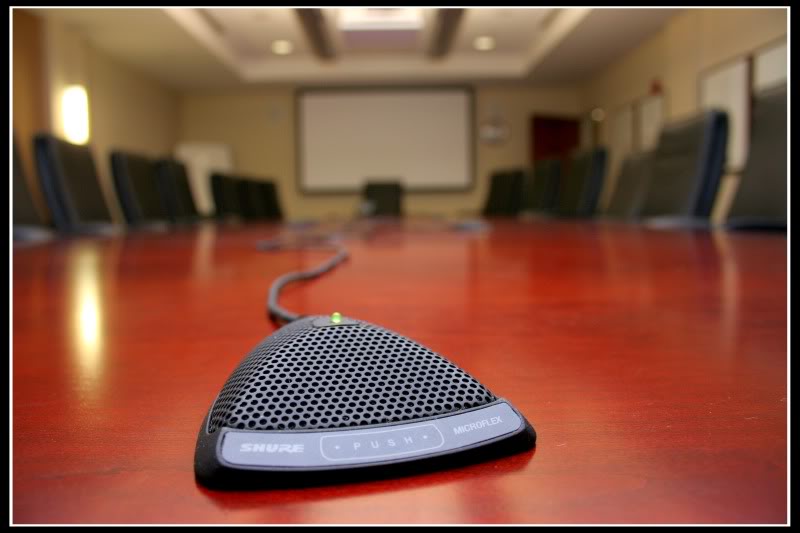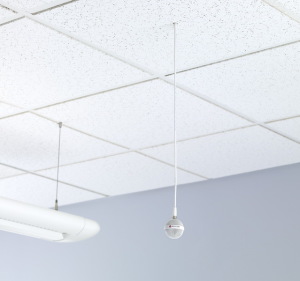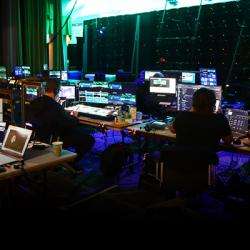Can You Hear Me?

As organizations continue to embrace technologies that enable remote collaboration such GoToMeeting, Adobe Connect, and WebEx, the environments in which they are being utilized are changing dramatically. As long as the screen displaying the content is sized appropriately, the room size does not impact the effectiveness of content sharing. However, what is impacted as room size increases is the quality and intelligibility of conference audio. The most important aspect of collaboration is the ability of all parties to hear one another clearly. As room size increases, the ability of traditional desk phones or conference phones to support quality collaboration decreases.
There are a number of solutions available to solve the problem of declining intelligibility, but selecting the right one is the challenge. Considerations need to be made regarding how the room is used, the room size and the furniture. These considerations are complicated by a trend towards placing microphones in a less than acoustically ideal position relative to those who will be doing the speaking.
What Is Critical Distance?
In a perfect world each person who speaks will have an individual microphone to use, but this option can quickly get expensive. Other more affordable options are available and require the consideration of the Critical Distance of the presenter from the nearest microphone. The ideal Critical Distance, which must also take into account room acoustics, is less than two feet from a participant to the nearest microphone; over five feet is considered unacceptable. Tabletop microphones can easily be positioned within the ideal range, while ceiling microphones cannot.
Microphones installed at ceiling height have disadvantages over and above simply being beyond the acceptable Critical Distance. They are prone to picking up ambient sounds within the space that further interfere with the intelligibility of a conversation. Background noise such as air conditioning and heat, noise from the floor above, vibration and projector fans all negatively impact audio quality.
What Are Digital Signal Processors?
Critical Distance is about the physics of microphone placement. Audio quality can be improved with Digital Signal Processors (DSP’s). DSP’s enable a skilled audio engineer to electronically modify the sounds that the microphones will pick up. They can tune out certain frequencies, amplify the pickup of certain microphones or not transmit any sound until the microphones pick up a certain noise level. While quality DSP in a system contributes to system stability, it cannot make up for poorly planned physics so it should only be used to adjust for any anomalies within an acoustic environment.
What Microphone Options
Do I Have?
So, what are your options for microphones and how will they work for you? Microphone technology continues to improve, giving us more options than ever before.
 Goosenecks
Goosenecks
As mentioned earlier goosenecks are some of the best microphones for conferencing and collaboration. They have gotten slimmer and more stylish through the years and they are less susceptible to table bumping or paper shuffling noises.
Button Microphones
 Button microphones are low profile and unobtrusive. Coupled with a mic collar, these compact mics provide visual cues: green for a live mic, red when muted.
Button microphones are low profile and unobtrusive. Coupled with a mic collar, these compact mics provide visual cues: green for a live mic, red when muted.
 Boundary Microphones
Boundary Microphones
Larger than button microphones, Boundary mics can have an LED light to indicate its status. Based on the shape of the microphone they can also have mic element that has a wider pick up pattern. Boundary Microphones may come with a push to talk/push to mute option.
Wireless Microphones
 Wireless technology has improved dramatically over the years. More channels are available, security has improved and there are now reliable gooseneck, boundary and Lavaliere microphones available in a variety of different transmission formats including:
Wireless technology has improved dramatically over the years. More channels are available, security has improved and there are now reliable gooseneck, boundary and Lavaliere microphones available in a variety of different transmission formats including:
- IR
- RF
- UHF
- 802.11
Ceiling Microphones
 I know… I mentioned earlier that ceiling mics are almost always outside the critical distance for effective speech transmission. However, there are situations where a room has a very flexible configuration and requires mics for a large number of people. In these scenarios, ceiling mics are a solution to consider. The technology has improved with multi-element microphones and beam forming technology making ceiling mics more stable than in the past.
I know… I mentioned earlier that ceiling mics are almost always outside the critical distance for effective speech transmission. However, there are situations where a room has a very flexible configuration and requires mics for a large number of people. In these scenarios, ceiling mics are a solution to consider. The technology has improved with multi-element microphones and beam forming technology making ceiling mics more stable than in the past.
It is always a good idea to have a professional audio engineer review your microphone layout to ensure adequate coverage and acceptable communication for video collaboration. This is especially true when using ceiling microphones. Remember the first thing people say when they connect to a video conference or Video Collaboration call isn’t “Can you see me?”, it is “Can you hear me?”. Video is a phenomenal business tool that drives efficiency, but it is only effective when paired with quality audio.
Share This Article
Categories
Latest Posts

Philadelphia 2026: Is Your Venue Ready for the Spotlight?

Scalable AV Infrastructure for Life Science Enterprises

Extend Your Reach: The Power of Virtual and Hybrid Events

Why Every Detail Matters in Investor and Year-End Meetings

IMS Technology Services Welcomes John Beaulieu
Tags
Contact Us
- Headquarters: 3055 MCCANN FARM DRIVE, GARNET VALLEY, PA 19060
- Event Staging: 2000 COLUMBIA AVENUE, SUITE 300, LINWOOD, PA 19061
- Southeast Office: 404 SUNPORT LANE, SUITE 350, ORLANDO, FL 32809
- Phone: + 610-361-1870
- Contact Us
Services
Recent Posts

Philadelphia 2026: Is Your Venue Ready for the Spotlight?

